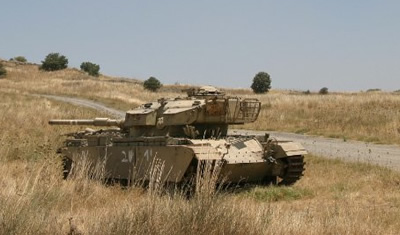The Battle of Golan Heights was a battle between Syrian and Israeli forces that took place at the beginning of the 1973 Yom Kippur War.
During the Battle of Golan Heights, Syrian tanks vastly outnumbered Israeli tanks. However, the Israelis were able to defeat the Syrians, largely because of the superiority of Israeli tanks.
The Israelis improved older tanks by uprgrading their weapons, armor and powerplants.
For example, they created the Magach by taking M48 and M60 Patton tanks from West Germany and the United States and adding a 4.13 inch (105mm) gun and a more powerful diesel engine.
The Israeli Sho’t was a British Centurion tank with a 4.13 inch (105mm) L7 gun. Some versions of the Sho’t had upgraded armor and upgraded fire control systems.
M50/51 Shermans (Super Shermans), which consisted of Sherman chassis with AMX-13 CN 75-50 guns, had been used by Israel as far back as the 1956 Suez Crisis.
 The Golan Heights is a strategically important region bordering Syria, Israel, Jordan and Lebanon. It was considered a part of Syria before Israel seized it in the Six Day War.
The Golan Heights is a strategically important region bordering Syria, Israel, Jordan and Lebanon. It was considered a part of Syria before Israel seized it in the Six Day War.
After the war, Israeli soldiers guarded the region.
Syria attacked the Golan Heights on October 6, 1973.
For months before the attack, Syrian forces worked on creating a false sense of security among the Israelis by repeatedly removing their tanks’ camouflage netting and arranging their tanks in battle formation below the Golan Heights. The Syrian tanks would remain in formation for a few days and then return to base.
On October 6,when religious soldiers were observing Yom Kippur and the border was less heavily guarded than usual, Syrian troops once again went through the procedure of taking the camouflage netting of their tanks and moving them into battle formation,.
The Israelis still were not sure what was happening.
Suddenly, the Syrians launched an air attack, and Syrian gunners began firing along the entire front.
The Syrians then launched simultaneous attacks in the north and the south.
It took between 10 and 15 hours for Israeli reservists to arrive at the scene.
When the battle began, the Syrians had 800 tanks: T-55s and T-62s.
Initially, Israel was able to deploy only 176 tanks: Magachs and Sho’ts used by the Barak Brigade in the South and the 7th Armored Brigade in the north. Israel’s resources were limited, as Israeli troops were also fighting Egyptian forces in the Sinai, which had attacked Israel on the same day.
At the end of the first day of fighting, the Barak Brigade had only 15 serviceable tanks.
However, as the fighting continued, and both sides received reinforcements, the superiority of Israeli tanks became clear.
It was reported that two Sho’t tanks were able to destroy dozens of Syrian T-55s and T-62s.
Within a week, the Syrians lost about 1,000 tanks.
After their victory on the Golan Heights, the Israelis then went on to invade Syria. They were able to get within 30 miles (48 kilometers) of Damascus.